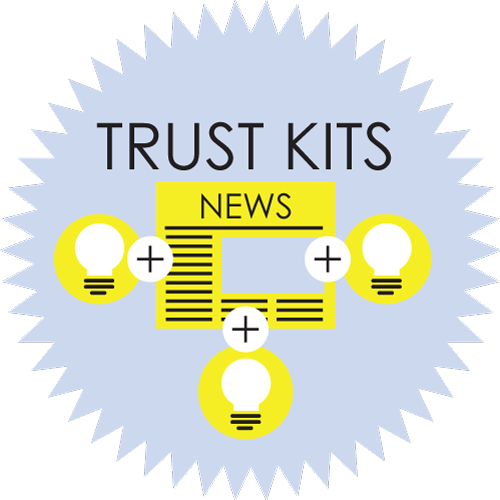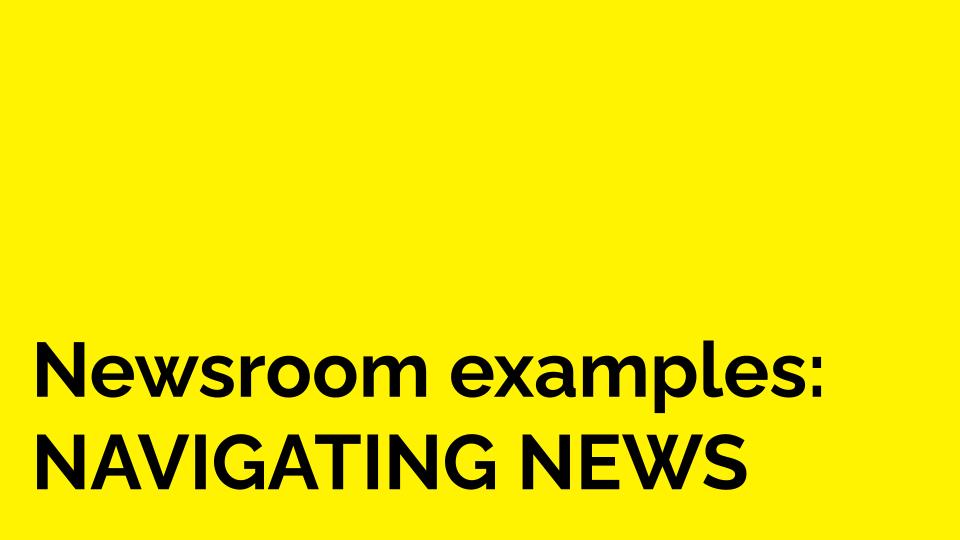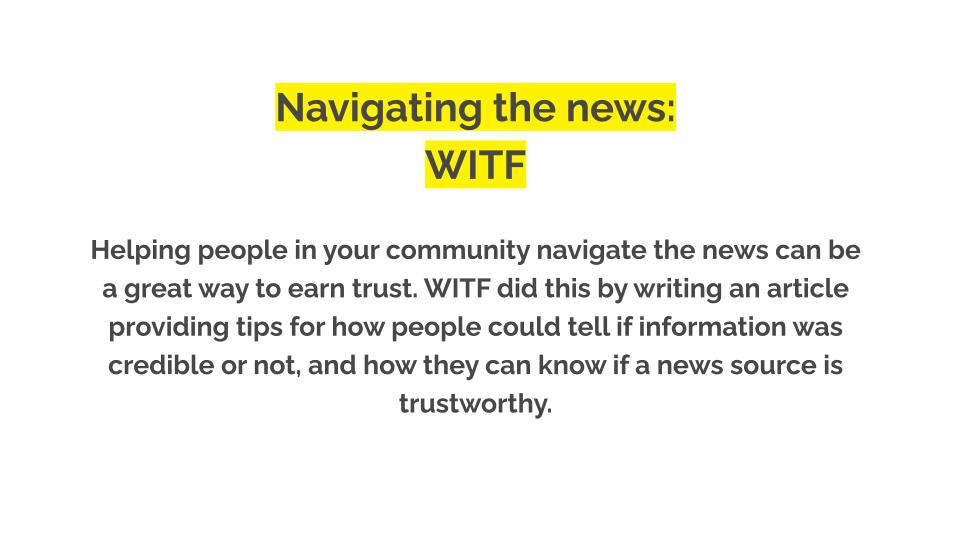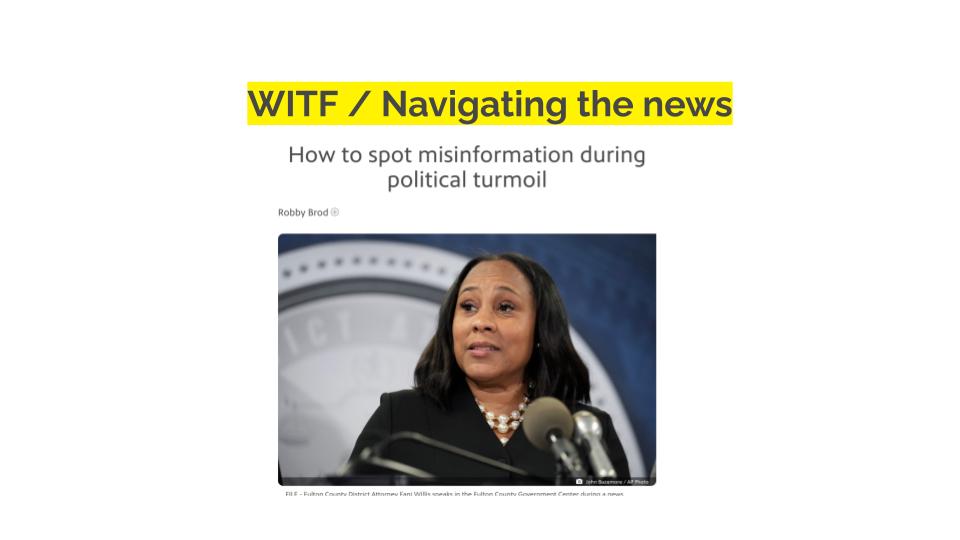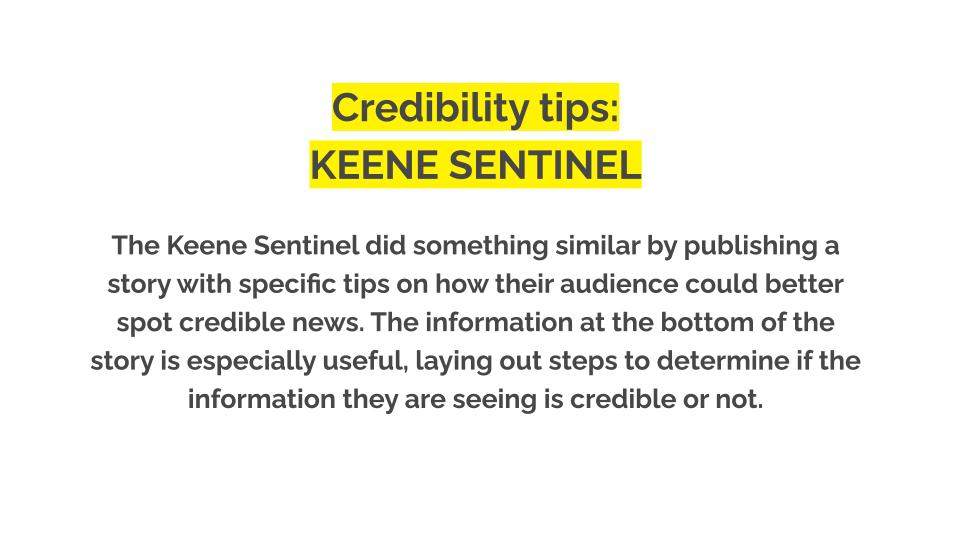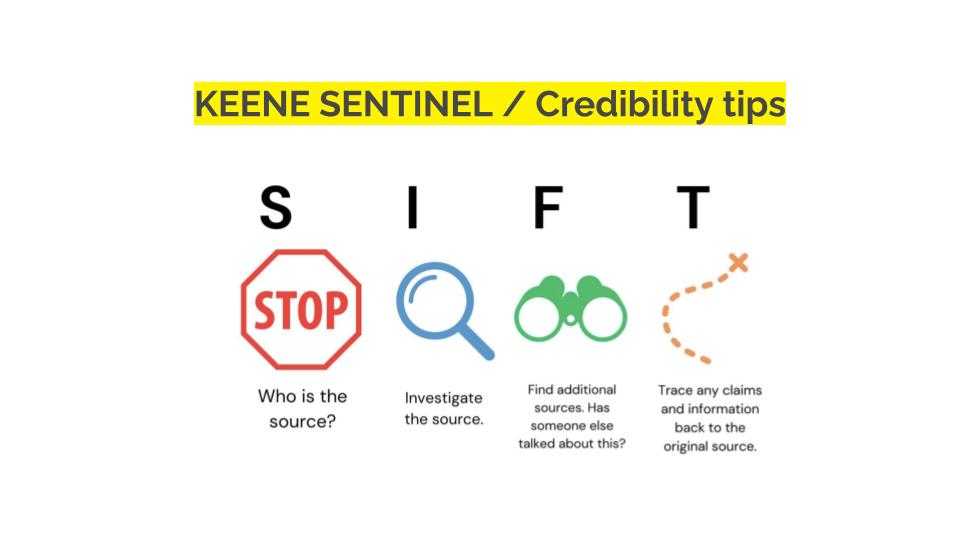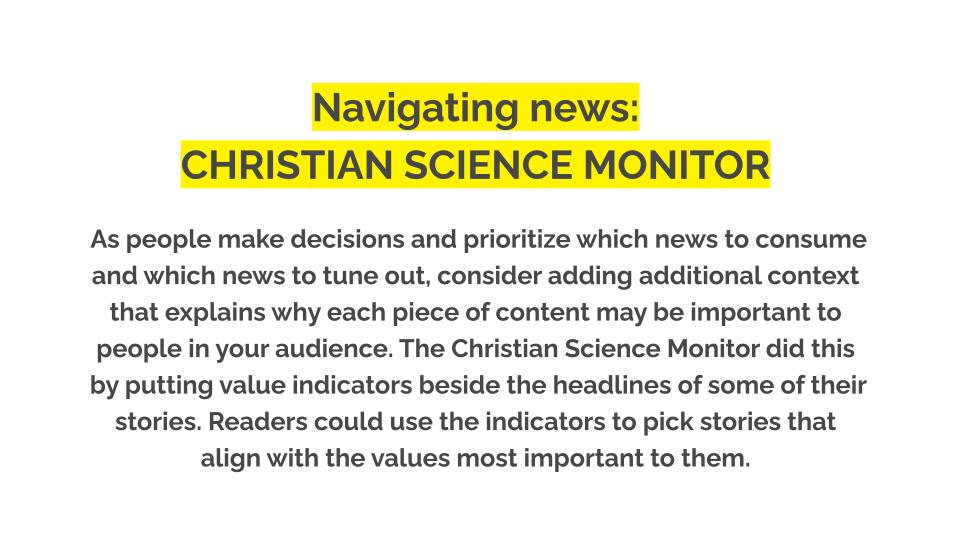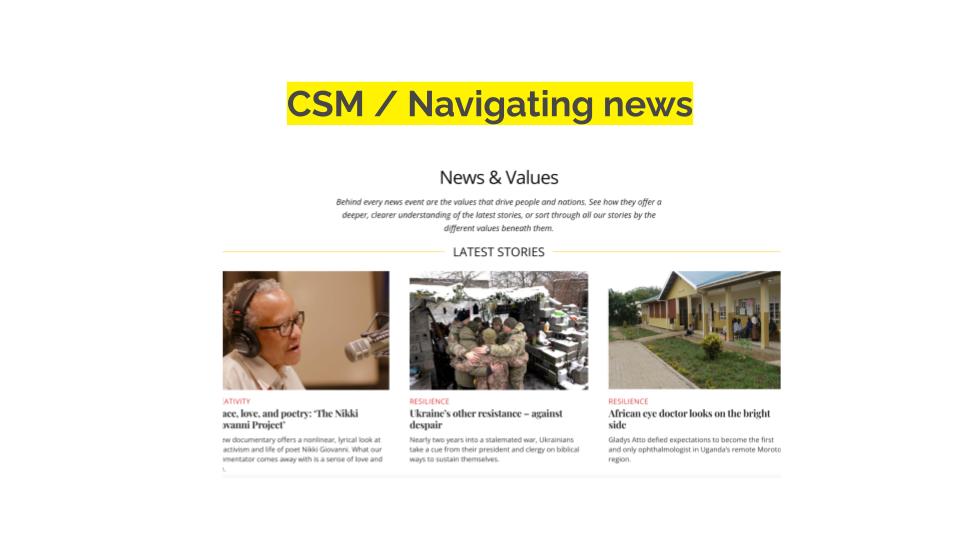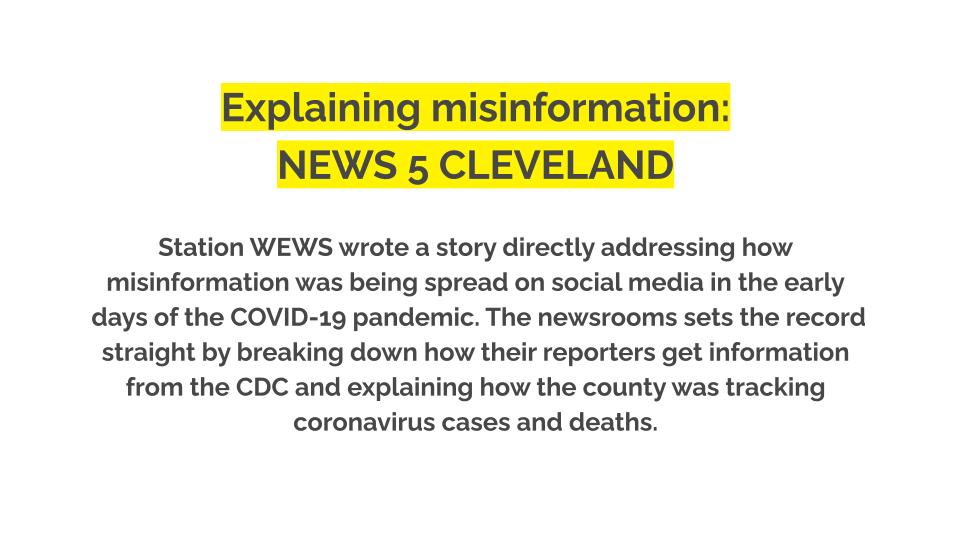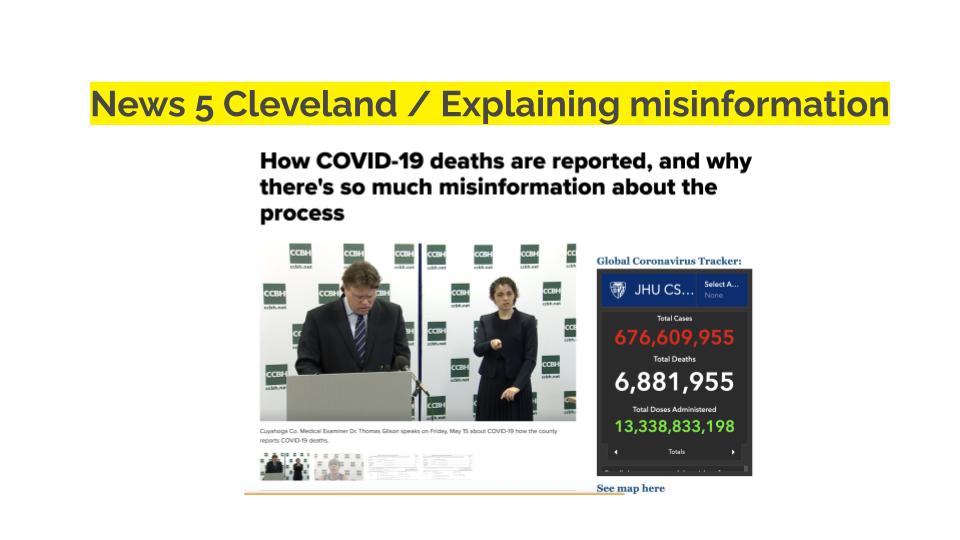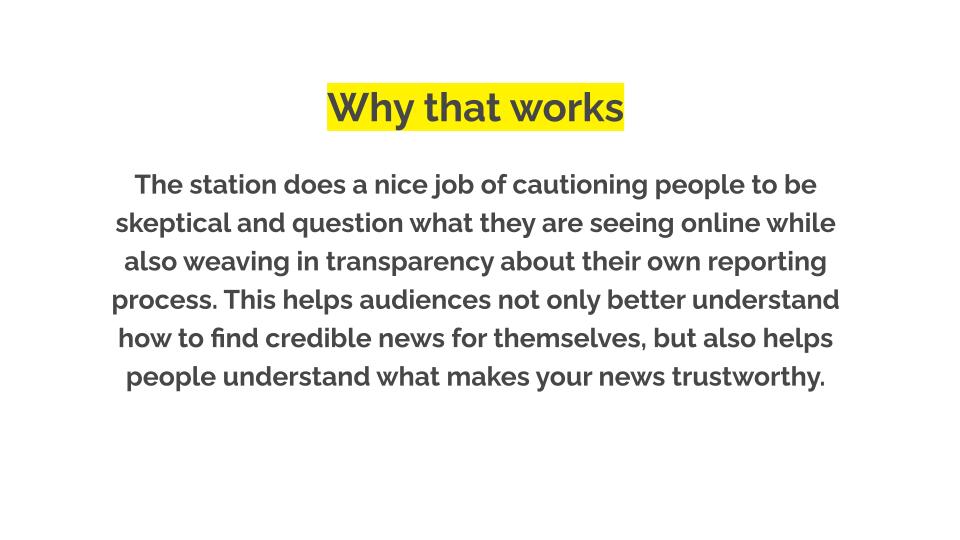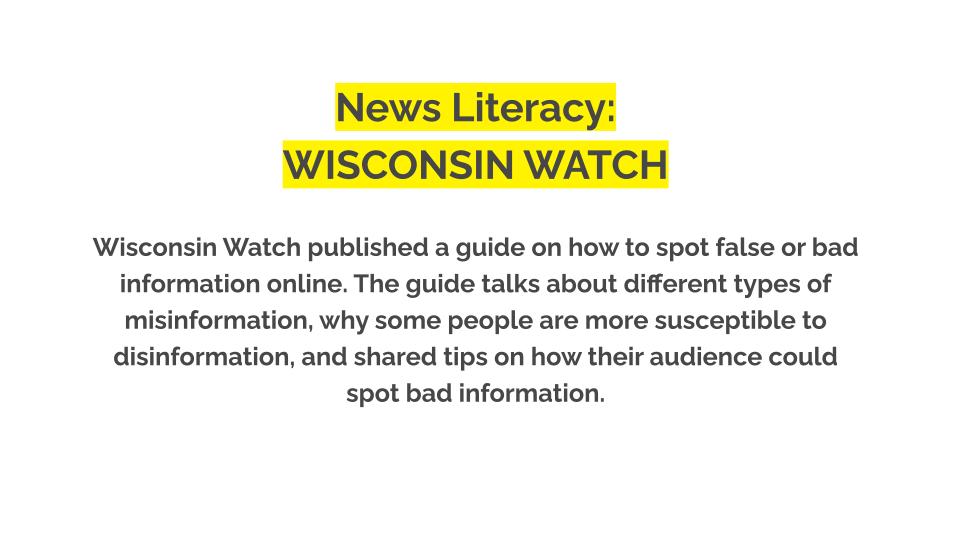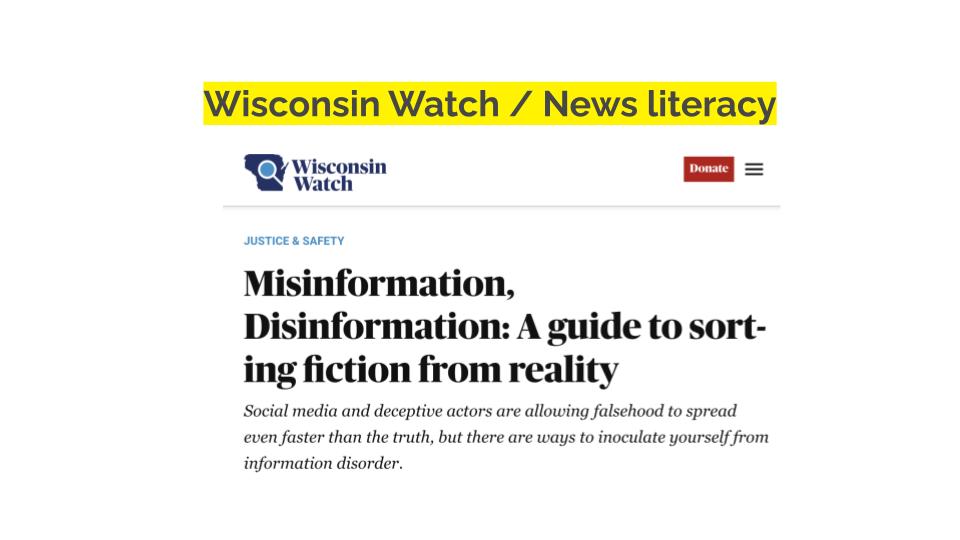HOW NEWS WORKS
This Trust Kit was created in partnership with The News Literacy Project, a non-profit working to build a national movement to create a more news-literate America.
Navigating and understanding news
It would be great if people were more discerning about what they believed. If they didn’t trust everything they saw online — both from intentional misinformation purveyors and from well-meaning (but inaccurate) friends and family.
As journalists, our job is to keep people informed. But our job doesn’t just end with sharing what we know is good information. We also have a responsibility to help people understand what makes news credible.
If people aren’t able to tell what’s quality news, or spot when there are bunk sources, it can lead to all sorts of issues — like misinformation spreading and a lack of informed civic engagement. It can also lead to problems for us as journalists. If people can’t tell what constitutes good news, why would they turn to us as a trusted source over other avenues of information? Will they know what sets our news apart from other information? Will they see the value we provide and want to support us? Unfortunately the answer is probably not.
If our mission as journalists is to keep people informed, then part of that mission involves making sure our communities know how to get good information for themselves.
If our mission as journalists is to keep people informed, then part of that mission involves helping our audiences find credible news for themselves.

Goals
This Trust Kit helps:
- Learn how to insert news literacy into daily coverage
- Get transparent about your basic reporting processes
- Employ strategies so your audience can navigate news
- Help your audience avoid news fatigue
- Talk about “the media” with friends and family
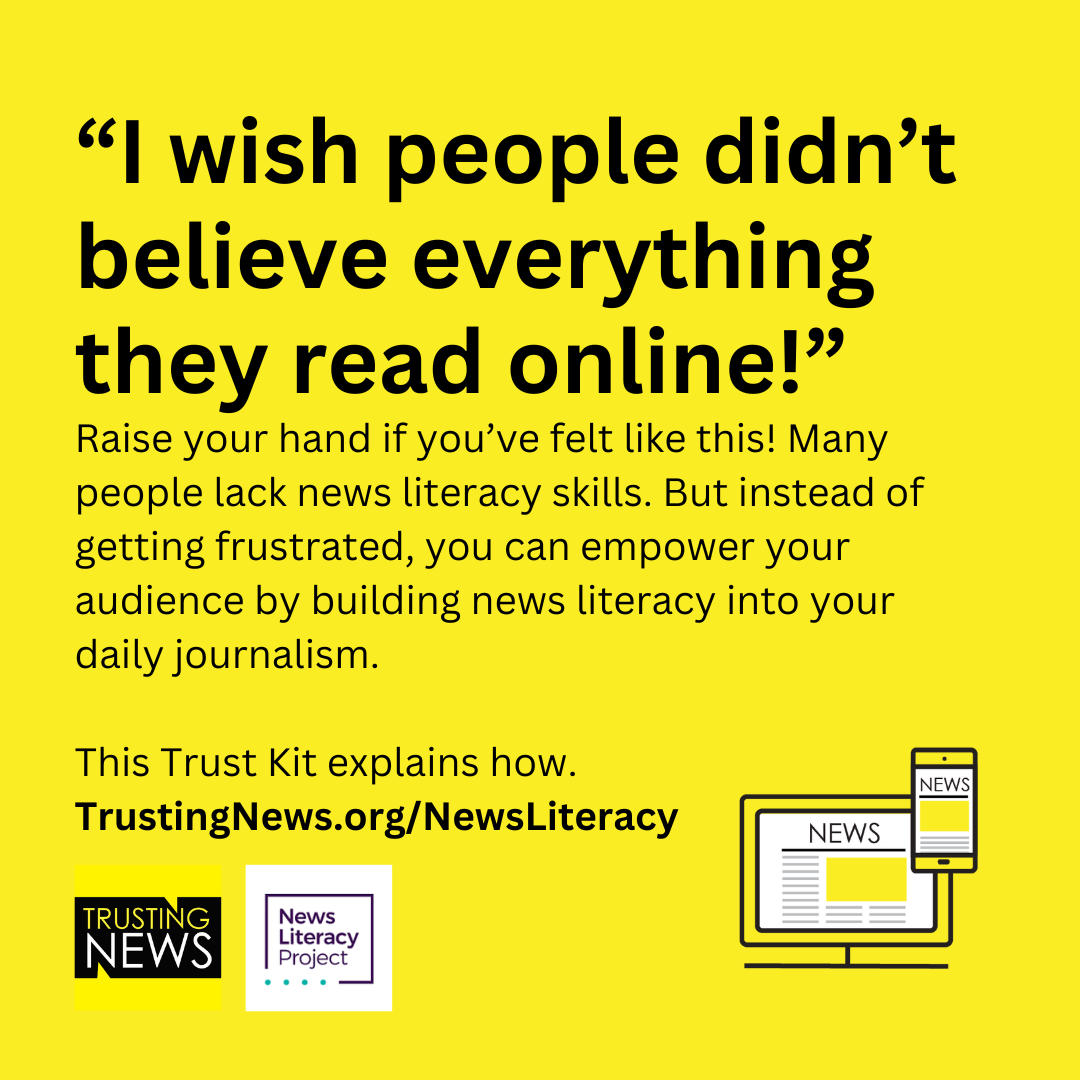

Take action
When we talk about news literacy, it goes beyond just helping educate the public. There are also lots of ways we as journalists can better explain how our journalism works and why it’s trustworthy. And the more people understand how you do your journalism, the more likely they are to trust your work and understand you have good motives.
Here are ways you can build this type of news literacy into your daily journalism. Click or tap the blue boxes to expand each section.
Delete and correct misinformation
We hope you agree with us when we say that deleting and correcting misinformation is important — especially when that misinformation is being shared in a Facebook group you manage or underneath a link your news organization posted on social media. It’s so important to moderate your conversation spaces. Do not be afraid to delete links to stories that include false information. Do not hesitate to delete images that are altered. Do not feel bad about preventing someone from posting in a group if they continually share misinformation. (As a comment moderator, try thinking of yourself as the host of a party. You wouldn’t let someone come into your party and yell inflammatory lies, right?)
Show your work
We know people don’t give journalists the benefit of the doubt. That means people won’t automatically assume you’re credible, so it’s up to you to be transparent about your reporting process and explain how it works. Think about the ways you can pull back the curtain on how you produce your work, especially places like social media where audiences interact with content very briefly and might only glance at a headline before scrolling on. Start by including what your reporting process looks like in the post chatter. Share what makes your sources credible or how you found documents. Explain how you verified information. And take the time to respond to comments accusing you of misinformation or “fake news.”
Explain what you're NOT covering
Your audience notices what you cover and wonders about what you don’t cover. If you don’t let them in on your process, people will make all kinds of assumptions about your motivations and decision-making. They may assume a reporter is friends with the business owner featured in a story, or the boss’ kid goes to the school highlighted in a story, or a politician paid you to cover a topic or event.
Instead of letting misassumptions damage people’s trust of your coverage, let your users know what criteria you DO use when deciding what to cover. For more on this, check out our Trust Kit on explaining coverage decisions.
Explain how you cover breaking news
Breaking news is ripe for misinformation. News is actively unfolding and it’s not uncommon for news outlets to initially report something that will later change or be updated. It’s easy to see how these situations can be confusing for people and may cause them to question the credibility of the news they are seeing.
So start by explaining how you cover breaking news. Work with your newsroom to develop language you can add to breaking news stories (online, in print and on-air) to explain how quickly information changes in these situations and what your approach is. Let your users know you report the most accurate and best information you have at that moment, but that information from officials can quickly change. Talk about how you will update the information and where the latest updates can be found. (Will it be online, or on social? Will you remove incorrect information?) Consider adding language that makes it clear that the facts in these situations can change and that information is moving quickly.
You can also share this News Literacy Project infographic that breaks down things people should watch for and understand when breaking news is unfolding.
Clearly label content
How many times has someone accused you or your organization of bias, and what they felt was biased was an editorial or column? Not being able to tell opinion content from news content can be frustrating for users. And usually for good reason: News organizations often don’t make it easy to tell the difference between these two types of content.
So make sure to clearly label what’s opinion content and what’s not — especially on social media. Stop using journalism jargon like “op-ed” or “editorial” and instead use more commonly used terms, like “opinion.” And to take it a step further, explain how your newsroom staff keeps the two content types from influencing each other. Check out this Opinion Trust Kit for more guidance on how to do this.
Help people spot bad information and "fake news”
“Fake news” comes up so often in conversations about news, likely because research shows it’s a major concern for many people. But oftentimes, people conflate “fake news” with news they disagree with, or perhaps an error a news organization made one time. So if someone brings up “fake news,” commiserate with them. Talk about how it’s a big problem for journalists, too. Share your experience of how most journalists try hard to get things right, but are human and sometimes make mistakes.
You can also help them level up as news consumers by giving them tools to decipher what’s credible information for themselves. Here are some tools we’d recommend sharing:
- A News Literacy Project checklist and infographic of how to vet information and sources to help your audience verify if something they see online is legit or not.
- News Literacy Project’s RumorGuard, a tool that helps people determine when viral news may be false or contain misinformation.
- Interactive News Literacy Project quiz that will help them practice and understand what credibility in news looks like.
-
ProPublica has a list of helpful questions for people to ask when evaluating misinformation.
Encourage skepticism
It’s easy to get defensive when people question your credibility. But shouldn’t we encourage our audience to be skeptical of what they consume? Aren’t we as journalists also skeptical by nature? Instead of getting frustrated and throwing up your hands, encourage your audience to question what they see and proactively give them tools to help decipher good information from bad information. (Check out the section directly above, “Help people spot bad information” to see some News Literacy Project tools you can share directly with your audience.)

Confronting news avoidance
It’s important people understand the world around them, but we can all agree that paying continual attention to breaking news alerts is exhausting.
Research from Reuters shows that 39% of Americans report they are news-avoidant. Research from Pew shows that two-thirds of Americans feel worn out by the news and that less Americans are closely following the news. We also know it’s negatively impacting people’s mental health, with 43% of Americans reporting that the news makes them feel worse emotionally.
It’s possible, of course, to find a middle ground — to stay informed without being consumed and alarmed by repetitive updates. As journalists, we can help our communities do this by offering a path through the news that avoids both extremes.
Here are some strategies for how you can help your audience navigate the news. Click or tap the blue boxes to expand each section.
Learn what news avoiders think of the news
If journalists want to help improve the news avoidance problem, the first step is truly understanding how people perceive and experience the news. This will help you have a better sense of what information needs are going unmet and ways your news organization can shift to respond.
We created a news avoider interview guide designed to lead you through a conversation with someone in your community who isn’t engaged with the news. your community members’ perceptions and experiences so you can think about how journalists might evolve to perform a more relevant public service to them.
As you have conversations with news avoiders in your community, we recommend keeping feedback in a centralized location in the newsroom so it’s easy to spot themes and overlaps as you talk to more and more people. (More guidance on how to do that here.)
Help develop habits around news consumption
Talk directly to your audience about ways they can be smart about their news consumption — of your product and others. Let them know that you take breaks from the news (you do, right?) and they should too. Suggest newsletters, podcasts and other products that are thorough but not overwhelming. Consider offering this advice in a newsletter, an online story, an Instagram story or even on-air. Ask for their suggestions and questions. Acknowledge their experience and build trust by being a resource they can turn to.
Empathize with people's experience consuming news
People don’t assume journalists care about people like them. On the contrary, we’ve heard from partner newsrooms that many people think journalists are just trying to get more clicks, however possible (which, in some cases, is true, right?). So start by first acknowledging to your audience that the news is often overwhelming, depressing and hard to read. If it’s been a heavy news week, acknowledge that and encourage them to take breaks if needed. You can also use it as an opportunity to point your audience to more solutions-based stories. (Research from the Center for Media Engagement indicates solutions journalism can help people feel more optimistic). By extending this level of empathy, you can signal to your audience that you DO care about them and their well-being and mental health. (Because, you do, right?)
Explain how news impacts their lives
As people make decisions and prioritize which news to consume and which news to tune out, consider adding additional context that explains why each piece of content may be important to people in your audience. Get specific about how certain topics you’re covering might impact them so people have an opportunity to prioritize.
The Christian Science Monitor does something similar where they put value indicators besides the headlines of some of their stories, so readers can pick stories that align with the values most important to them. Your newsroom could do something similar by adding a line to newsletters, on air, or on social media that gets specific about each story’s impact.
Show the unique value you offer
We also know that news avoiders often don’t see the unique value journalists offer, or understand how credible journalism differs from other sources of information.
This disconnect between journalists’ mission of public service and how the public perceives media is something we talk about often at Trusting News. News avoiders aren’t seeing the value journalists bring to the table, and they likely WON’T see it unless we’re actively communicating it — and backing it up with examples.
If your newsroom is working to be an antidote to what’s frustrating about the news, then you should get clear about the value you’re offering your community. Communicating this could look like explaining: what sets your journalism apart from other media, how you’re working to combat polarization, how you’re working to help people cut through the noise, etc. (This post has a list of questions to help you get started.)
Once you’re ready, share it with your audience but also beyond your audience (think where your content might reach news avoiders, like social media). We created a social Canva template you can copy and adapt for your newsroom.
Adapt your products for news avoiders
People felt very overwhelmed by the news, both by its volume and content. One way journalists can address this is by creating products or repackaging our coverage to feel more accessible and less overwhelming.
Here are three ways to do that. (For more in-depth guidance and examples, check out this post about adapting your products for news avoiders.)
1. Prioritize relevant, high-utility content: Get curious and learn whether you’re actually providing information that would serve the people who are avoiding news.
2. Make the news feel more accessible: Offer news that requires no previous engagement or knowledge, and that feels more approachable and accessible.
3. Help people feel easily caught up: Create news products that make it easy for people to catch up by giving just the ke highlights of what they really need to know.

Talking about “the media”
Whether it’s a family member, a friend or your Uber driver, once people know you work in media, you’ll be faced with questions from people who are genuinely curious about or have valid frustrations with journalism but might not have a firm understanding of how it works.
Here are some tips and strategies for how you can talk to your friends and family about “the media” and journalism as a whole. Click or tap the blue boxes to expand each section.
Don't defend the whole media industry
When people make sweeping statements about “the media,” it’s hard not to get defensive or to take it personally. But there’s a lot of journalism out there, and not all of it is good, right? So if someone is talking about how bad or biased the media is, remember that you don’t have to defend the whole media industry. It can go a long way to show that you have empathy for their perspective by agreeing that there is unethical journalism you don’t stand behind. But then perhaps follow up by sharing some resources and media outlets you find especially credible and helpful.
Get curious about their experience consuming news
Oftentimes when interacting with a journalist, people bring up a story or example of journalism they take issue with. So use that as an opportunity to be curious and inquire about where they saw this content and how they feel (or likely, don’t feel) represented by the news. Asking some general questions like this can help lead the conversation forward and ground it in a place of empathy and curiosity.
We have a community interview guide we often encourage journalists to use with people in their community who have low trust in news. While we’re not necessarily advising for you to sit down and do official interviews with everyone at the next big family reunion, you can use some of these questions to help productively direct the conversation.
Talk about what journalism is, and what it means to you
People tend to have a narrow view of what journalism is (thinking it’s only crime, political coverage or investigations.) Remind them that journalism is that, but also that it’s so much more! Journalism is also the review of the new restaurant in town; a list of events happening this weekend; a map of where to see holiday lights around town. You can help people broaden their scope by sharing different elements of what your work looks like.
And, when it feels appropriate, share why it is you chose to work in journalism — whether that’s to tell people’s stories, to represent diverse voices, to act as a watchdog, etc. People don’t automatically think of journalism as a public service, so sharing the personal importance behind your work can help shift how people think of journalists and their motives.
Remind them journalists are real people
If they start making assumptions or using broad strokes to paint journalists’ motives, gently remind them that most journalists are like you — people who are part of their local communities who are affected by what happens there. They care, and most are trying their best to provide thoughtful, fair coverage. This Trust Kit walks journalists through how they can better talk about who they are.

Tips and tools to share with your audience
While we can’t control the spread of bad or inaccurate news, what we can do is give our users basic knowledge about the news-gathering process to help empower them to be smarter about their own news consumption. The more your audience understands how to spot fact-based information, the more likely they are to turn to organizations like yours as a trusted news source.
Thanks to our collaborators at the News Literacy Project for sharing these resources and tools. Their organization has been teaching the public to be better informed, more engaged and more empowered news consumers since 2008.
You could share these infographics and resources in a social media post, in a box that runs alongside an article, at the top of a newsletter — anywhere your audience is seeing your news. It can be especially important for newsrooms to share these whenever they see false or misleading information being shared locally — from other news outlets or on social media.
- Is it Legit?: A checklist and infographic guiding people through how to vet information and sources in order to verify if information online is legit or not
- News Lit Quiz: Is it Legit?: An interactive quiz that helps people practice and understand what credibility looks like in news
- Breaking News Checklist: An infographic that breaks down things to watch out for and understand when a story is still unfolding
- Quiz: How News Literate are You? An interactive quiz hat helps people understand how news literate they are
- Get Smart About News: A free weekly newsletter that offers a rundown of the latest topics in news literacy
See how other newsrooms do it
For inspiration, here are some examples of how newsrooms are helping their audience navigate the news. For more newsroom examples, check our our newsroom example database.
We’re here to help
Congratulations on getting this far in the Trust Kit! We know taking the steps to earn trust isn’t always simple or easy. It takes time and often requires a shift in newsroom routines or workflows.
Any progress you make on implementing strategies in this Trust Kit should be celebrated as a win!
If you find yourself getting stuck, need help brainstorming, or have completed the work in a Trust Kit and would like our team to review and give additional advice, reach out to us at info@trustingnews.org or send us a message on Twitter.
This Trust Kit was last updated Jan. 17, 2024.
